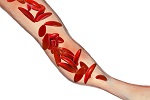
Thanks to an engineered blood cell, a Mississippi mom watched her son play football for the first time. Victoria Gray received stem cell therapy to treat her sickle cell disease. The painful blood disorder forms the hemoglobin inside red blood cells into sickle shapes.
Hemoglobin is what allows red blood cells to carry oxygen across the body. But these sickle shaped cells aren't flexible enough to enter tiny capillaries which puts people at risk for organ damage, stroke, and death. So, what scientist did was use a relatively new technology called CRISPR to modify Victoria's stem cells.
Rather than trying to change her defective gene, they gave her body a large dose of healthy fetal hemoglobin which our bodies make but in small amounts. First, they isolated stem cells from her blood and used CRISPR to turn on their fetal hemoglobin gene. Chemotherapy killed the rest of her defective stem cells and then doctors infused billions of the genetically edited stem cells.
A month later, the genetically modified cells began to do their job. By four months, nearly half of her total hemoglobin was the fetal version and making healthy cells. Even better, nearly ninety five percent of her red blood cells contained fetal hemoglobin. After one year, the edited cells continued to work so that she stopped needing transfusions or ER visits. Now Victoria has a chance at a normal life which gives hope to the one hundred thousand Americans with sickle cell disease.
More Information
A Year In, 1st Patient To Get Gene Editing For Sickle Cell Disease Is Thriving
Like millions of other Americans, Victoria Gray has been sheltering at home with her children as the U.S. struggles through a deadly pandemic, and as protests over police violence have erupted across the country. But Gray is not like any other American. She's the first person with a genetic disorder to get treated in the United States with the revolutionary gene-editing technique called CRISPR.
A Young Mississippi Woman's Journey Through A Pioneering Gene-Editing Experiment
When Victoria Gray was just 3 months old, her family discovered something was terribly wrong. "My grandma was giving me a bath, and I was crying. So they took me to the emergency room to get me checked out," Gray says. "That's when they found out that I was having my first crisis." Gray is now 34 and lives in Forest, Miss. She volunteered to become the first patient in the United States with a genetic disease to get treated with the revolutionary gene-editing technique known as CRISPR...
Incident of Sickle Cell Train in the US
Although the occurrence of sickle cell trait (SCT) varies greatly from state-to-state and among different races and ethnicities, every state and racial/ethnic population includes people living with the condition and many are unaware of their personal sickle cell status...